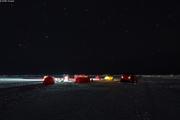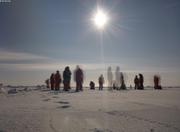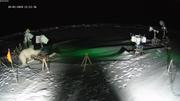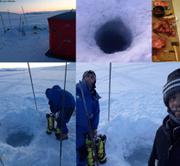Sea ice stories
Mosaic expedition keeps going, following the transpolar drift which is getting us slowly closer to the North Pole (less than 300km), and at the pace of a busy scientific program.
At 87°30' latitude North, even during the polar night, northern lights are very rare; we recently observed a green and red one. The full moon was also very beautiful with a penumbral eclipse on January 10th. And the starry sky as well while camping out on the ice last week-end: about twenty scientist accepted my invitation to leave the Polarstern cocoon for a night, to better feel the Arctic Ocean they are studying.
A well educated bear visited carefully part of the numerous instruments deployed on the ice, he didn't do any damage, and he even avoid stepping on the snow under the radiometers that look down at the surface and measure up welling radiations and surface temperature. Only one timelapse camera could see the bear, not long after midnight on January 19th. His foot prints told us about his route.
Ice has been breaking-up quite a bit in the Polarstern surroundings lately. Yesterday, while watching for two teams willing to work on the other side of a crack, ice was squeaking, moaning. Standing by near the opening and pressure zones, with two snowmobiles and three sledges parked on the 'right' side of the crack, I suddenly watched a multiple breaking. Ice was moving under my feet. One sledge ended up like a bridge on top of a one meter wide crack. When I started the snowmobiles, one ski was already touching the water! Luckily the engine was still warm and the machine jumped out of the crack just before sinking (4500m depth...). Simultaneously, a pressure ridge was growing fast, it was time to gather everybody and move back to our vessel. What will become the Mosaic floe?
At Vagabond near Arctic Bay, Louis had some help from one or two seals to keep his diving holes open in the ice and reduce his work before diving! With -36°C yesterday, water probably felt almost warm to him, at -1.8°C. In these conditions, it is a technical and logistical challenge to collect a tenth of coralline samples that were set up on the sea floor last September, and to download data from various loggers measuring light, temperature, salinity and pH. Johan, Leonie's teacher, was there to assist Louis from the surface, and friends from the community to warm up our diver with caribou, Arctic char and seal feast.




